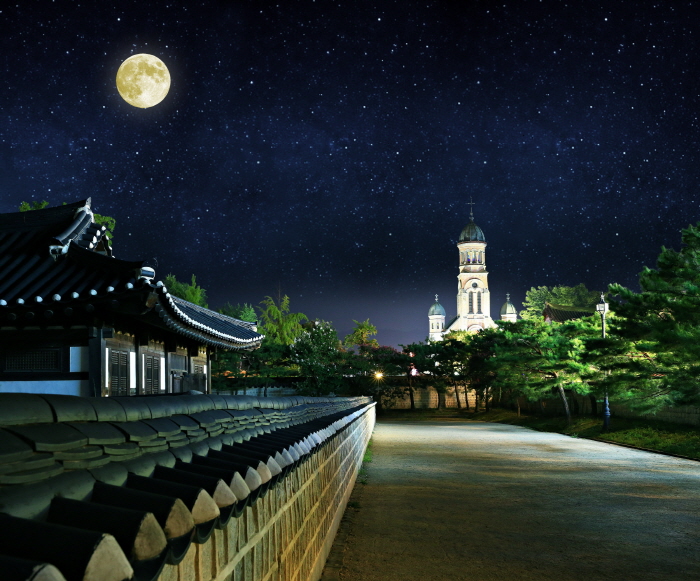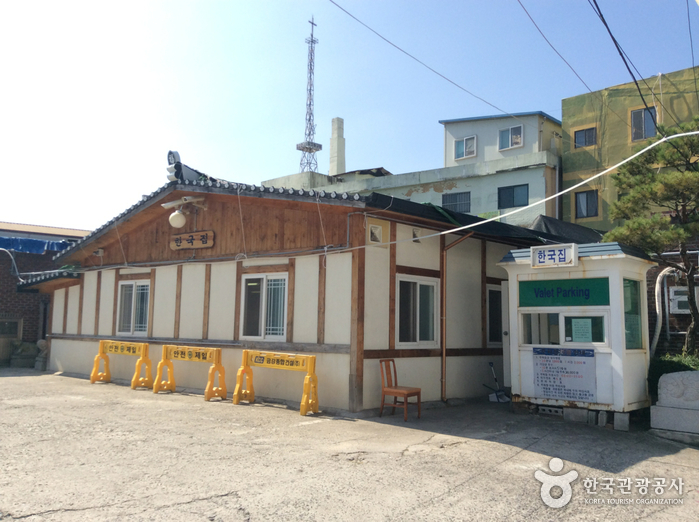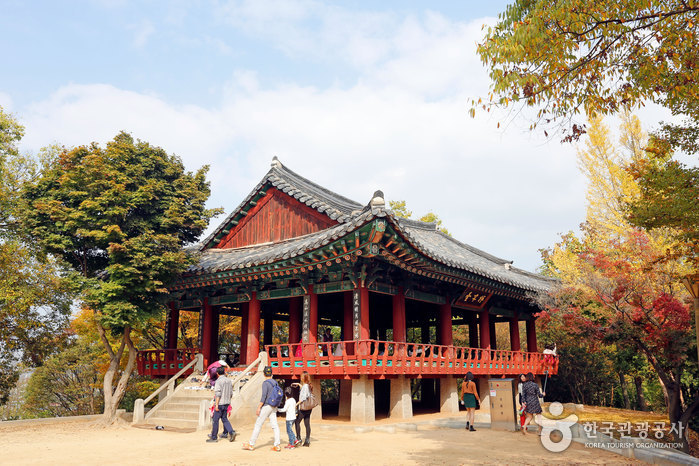Musée des portraits royaux (어진박물관)
278.3171835844381m 16770 2024-04-24
Taejo-ro 44, Wansan-gu, Jeonju-si, région Jeonbuk
+82- 63-231-0090
[Temple Gyeonggijeon; le lieu où est conservé le portrait du roi Taejo]
Ouvert le 6 novembre 2010, le musée des portraits royaux est l'une des toutes nouvelles attractions touristiques de la ville de Jeonju, situé dans le palais Gyeonggijeon. Le musée constitue ainsi une ressource documentaire importante à la fois pour la ville de Jeonju tout comme pour le temple Gyeonggijeon qui renferme le portrait du roi Taejo. Le musée qui se compose d'étage en sous-sol et en surface occupe une surface de plus de 1000m2. On peut y apprécier le portait de 6 rois en Corée en plus du portrait du roi de Taejo. Depuis son ouverture, le musée vise à devenir une place centrale pour la vie culturelle de la région. Le musée propose également diverses activités pour se familiariser avec la culture de la royauté en Corée.
Promenade avec roi (전주 한옥마을 경기전 '왕과의 산책')
278.3171835844381m 5478 2024-04-07
44, Taejo-ro, Wansan-gu, Jeonju-si, Région Jeonbuk
+82-63-232-9938
Le programme "Promenade avec roi" se déroule tous les samedis soirs à Gyeonggijeon. Il s'agit d'une nuit spéciale prévue pour 100 personnes à chaque séance ! Vous pouvez faire l'expérience de la vie sous la dynastie de Joseon sous la lumière de la lune tout en prenant une tasse de thé. De la musique et des guides vous accompagneront également pendant votre visite.
Sanctuaire de Gyeonggijeon (경기전)
283.68601987632974m 6382 2024-04-08
44, Taejo-ro, Wansan-gu, Jeonju-si, Région Jeonbuk
+82-63-281-2790
Le sactuaire de Gyeonggijeon a été élevé en 1410 pour abriter le portrait du roi Taejo, fondateur de la dynastie Joseon. Ce lieu saint comporte Jinjeon où se trouve le portrait, et Jogyeongmyo abritant les plaques commémoratives de Han Lee et de sa femme, ancêtres de la famille royale Lee de Jeonju. Détruit en partie durant l’invasion des forces japonaises (1592-1598), le Gyeonggijeon qui existe actuellement a été rénové en 1614.
Fine day [Korea Quality] / 좋은날 [한국관광 품질인증]
284.2451150948289m 7981 2024-04-07
37-7, Jeondongseongdang-gil, Wansan-gu, Jeonju-si, Région Jeonbuk
+82-10-2607-3326
Good Day is a traditional Korean house situated in Jeondong Catholic Cathedral Street in Wansan-gu, Jeonju, Jeollabuk-do. It was originally built in 1942 and remodeled in 2011 as a guesthouse by the current owner. The guesthouse has most of the features of a traditional Korean house still intact, but with modern amenities added for the comfort of the guests. The floor, walls, and ceiling are coated with red clay, and the ceiling rafters are visible as in most traditional Korean houses. Many guests say that sleeping in a room made of these natural materials helps them relieve fatigue. The rooms are well-insulated and warm for the cold winter days. The guesthouse is close to Gyeonggijeon Shrine, which enshrines a portrait of Taejo Yi Seong-gye, the first king of Joseon, and is conveniently located for those wishing to take a tour of Jeonju Hanok Village featuring hundreds of traditional Korean houses, Omokdae, and Jeondong Catholic Cathedral. In addition to these tourist attractions, there is also a traditional marketplace called Nambu Market with lots to eat and see. The guesthouse owner named it "Good Day" because he wishes all his guests to have a good day during their stay. He decorated every corner of the guesthouse with this in mind. The grass yard and colorful garden are beautiful throughout the seasons. The garden includes a mix of wild flowers, pine nut trees, fig trees, pomegranate trees, grape vines, and jujube trees. The “toetmaru (open living room with wooden floor)" right in front of the garden is also decorated with small flowerpots. The “toetmaru” is the most popular place among the guests because it’s a great place to enjoy the sun and breathe in the scent of flowers. On a rainy day, you can hear the raindrops falling down the eaves. There are six guestrooms at the guesthouse, named "Spring Waltz,” “Summer Tiffany,” “Autumn Pomegranate,” “Winter Festival”, "Sunshine", and "Welcome." The ceiling rafters are visible in all the rooms as in most of traditional Korean houses. The rooms are furnished with TV, refrigerator, and air conditioner. The bathroom comes with shower booth and bidet. People of different age groups come to stay at this guesthouse, and most of them say the guesthouse is clean and comfortable to stay in, thanks to the owner who sun-dries the sheets and blankets on the rooftop, cleans the rooms, and cultivates the garden every day of the year to make sure that the guests can have a comfortable, memorable stay. The guesthouse is conveniently located near a number of tourist destinations as well.
Bu Yong Heon [Korea Quality] / 부용헌 [한국관광 품질인증]
329.03936764426965m 11203 2024-04-07
149-3, Hyanggyo-gil, Wansan-gu, Jeonju-si, Région Jeonbuk
+82-10-8646-0964
Buyongheon is located in Jeonju Hanok Village. Precisely speaking, Buyongheon is the very next door to Jeonju Hyanggyo (Confucian Temple and School). Across the alley are Jeonju Hyanggyo Culture Center and Wanpanbon Culture Center. If you walk a few more steps, you will reach Jeonju Hanbyeok Culture Center where you can see various performances and experience the culture and foods of Jeonju. Omokdae can be seen from the garden of Buyongheon. Across the Jeonjucheon Stream is the National Intangible Heritage Center.
The beginning of Buyongheon is deeply related with Jeonju Hyanggyo. In around 1935, the local bureaucrats lived around the Hyanggyo after building 12 houses one after another. Most of them came from rich families. These collective houses were called Buyong Houses, which meant rich houses. The name Buyongheon originated from Buyong Houses. The rooms of Buyongheon are composed of Toenmaru Bang, Daecheong Maru Bang, Large Daecheong Maru Bang and Big Sarangchae. The interior of the rooms looks neat with the beauty of blank space as they excluded unnecessary decorations. Carefully prepared breakfast is served upon request made in advance. Visitors can also experience traditional culture such as traditional etiquette education and Korean paper art.
In fall, the yellow leaves of the ginkgo tree in the garden of Jeonju Hyanggyo lights up the roof of Buyongheon. It is recommendable to walk along the Jeonjucheon Stream and take pictures of the colorful murals and the cafes in the Jaman Mural Village located on the left sie of the Hanok Village. It takes 15 minutes from Jeonju Station and 10 minutes from Jeonjuu Express Bus Terminal to Buyongheon by taxi.
The Hanok [Korea Quality] / 더 한옥 [한국관광 품질인증]
337.9006441016934m 875 2024-04-07
68-15, Eunhaeng-ro, Wansan-gu, Jeonju-si, Région Jeonbuk
+82-10-2189-4002
The Hanok was transformed into a new style of hanok by combining the traditional structure (built in 1975) with a modern hanok style. Located in Jeonju Hanok Village, this large hanok is composed of a ‘ㄱ’-shaped bonchae (main building, 7-kan*), a sarangchae (men’s quarters, 3-kan), a large courtyard, and a platform for crocks of sauces and condiments. The house accepts only a limited number of people so that guests can enjoy a relaxing stay amid a pleasant, spacious environment.
Each room is built with “well-being” construction materials such as Hinoki cypress wood, red clay, and hanji (traditional Korean paper handmade from the mulberry tree). As for the four rooms of the anchae (women’s quarters), ‘Gwibin’, the largest room, is suitable for two families. It is heated with the ondol system (Korean floor heating system), and has a body massager and two king-sized beds. ‘Eoulim’ has an attic and a high ceiling with exposed rafters and crossbeams. Both rooms are equipped with two bathrooms.
The ‘ㅡ’-shaped sarangchae opposite the courtyard has three guestrooms. In particular, ‘Byeolhana’ has a red clay bed with ondol heating; while ‘Byeolset’ features a bunkbed made of wooden materials originally used in the construction of the house.
The Hanok provides a ‘Moonlight tea meeting’ where guests can enjoy tea and conversation under the moonlight in the large courtyard.
*kan - a unit of measurement referring to the distance between two columns.
Damun (다문)
361.6675737527907m 8127 2024-04-07
74-8, Eunhaeng-ro, Wansan-gu, Jeonju-si, Région Jeonbuk
+82-63-288-8607
Situated in Jeonju Hanok Village, Gyo-dong, Jeonju-si, Damun serves Korean table d’hote in a restaurant divided into large and small rooms within a hanok building structure.
Gyodonggaon [Korea Quality] / 교동가온 [한국관광 품질인증]
366.4860275791494m 7285 2024-04-07
73-1, Eunhaeng-ro, Wansan-gu, Jeonju-si, Région Jeonbuk
+82-10-5106-3355
Gyodong Gaon is located right in the middle of the main street of Jeonju Hanok Village. The word "gaon" means "middle" in Korean. It's a two-story traditional Korean house that stands out among the rest of the traditional Korean houses in the alley leading to Omokdae. Just inside the gate is a yard with colorful flower trees, jars of sauces, and furnace. The mural on one of the walls is popular among the guests as a place to take photos.
The "numaru", or "loft" in Korean, overlooks the Hanok Village, and is one of the best places in the village to get a closer look at the 500 year old zelkova tree and the foot of the mountain nearby. Open to all the guests, the "numaru" is very popular during the winter as well as the summer. It's an open space with a wooden floor, so it's very cool during the summer, and it also serves as an observatory to enjoy the view of all the snow-covered trees and roofs in the Hanok Village during the winter while having a hot cup of tea.
The owner of the guesthouse has been living here for 37 years. He rebuilt his house and turned it into a hanok guesthouse in 2014 while making sure the rooms are well insulated and comfortable to stay.
He built a two-story building to make an efficient use of the space, and focused on making all the rooms look different. The house has five rooms, and only the “Meomulda Room” on the first floor is the only rooms with a living room separated from the bedroom. All you have to do is open the door to enjoy the view of the yard, Hanok Village, and Omokdae. The “Nanuda Room” on the second floor is the largest one that can accommodate more than five people, making it the most popular choice among families. The "Damda Room" and "Kkumkkuda Room" both have an attic that can be reached by a ladder. The attic is big enough to sleep two adults, and some guests actually sleep there for a unique experience. One of the walls of the attic is finished with cypress wood which has a pleasant scent. The “Geurida Room” has the best view through the two windows on the either side of the room, in addition to warm sunlight and cool wind that come through the window. Modern, not traditional, doors are installed in all the rooms for better sound proofing and insulation.
Gyodong Gaon offers a number of experience programs, such as traditional games like “gulleongsoe”, “tuho", and “Korean top”, As well as “sabang chigi”, “sampalseon”, and “ttangttameokgi”.
Many Korean adults are familiar with these games, while children and foreigners can find these games interesting. All these traditional Korean games are free to play.
Hankookjib (한국집)
373.05733489851247m 14711 2024-04-07
119, Eojin-gil, Wansan-gu, Jeonju-si, Région Jeonbuk
+82-63-284-0086, 2224
Hankookjib literally means 'Korean house.' The restaurant serves Jeonju bibimbap, kongnamul haejangguk (spicy bean sprout soup), sagol gomtang (thick beef bone soup), doenjang jjigae (soybean paste stew), and samgyetang (ginseng chicken soup). Many well-known figures, including former presidents of Korea, have been sited as enjoying the authentic Jeonju bibimbap here.
Omokdae et Imokdae (오목대와 이목대)
374.6216652667476m 6058 2024-04-08
1-3, Gyodong 1-ga, Wansan-gu, Jeonju-si, Région Jeonbuk
+82-63-281-2114
Omokdae, situé en haut d'une colline est le lieu où Yi Seong-gye (qui devint plus tard le Roi Taejo) s'arreta pour célébrer sa victoire lors d'une bataille contre l'armée japonaise au Mont Hwangsan à Unbong vers la fin de la période Goryeo. C'est aussi là où Mokjo, l'un des ancêtres de Yi Seong-gye, vécut. Plus tard, le Roi Gojong y établit une statue monumentale, “Taejogohwang Jejupilyujibi” avec une phrase écrite de sa propre main. De l'autre côté de Yukgyo, à partir d'Omokdae, se trouve Yimokdae, au pied du Mont Seungamsan où Chimyeongjasan, sité sacré pour les catholiques demeure. A 80 m de Yimokdae se trouvent un mémorial et une maison. “Mokjodaewang Gugeoyuji”, la phrase gravée sur le monument en pierre, fut écrite par le Roi Gojong en personne. Mokjo est le cinquième ancêtre du Roi Taejo, qui fonda la Dynastie Joseon. Imokdae est connue pour être le lieu où Mokjo vécut, jouant à des jeux de formation de bataille avec ses amis étant enfant. Cette anecdote apparait également dans le Yongbieocheonga (ballade du 15e siècle narrant la longévité nationale et la réussite culturelle). Mokjo se rendit à Hamgyeong-do à partir d'Imokdae (à Jeonju) en raison de la querelle qu'il eut avec le Jeonju Busan (officiel de l'etat gouvernant la région de Jeonju). Yi Seong-gye pensa que le départ de Mokjo était quelque chose ayant été guidé par les dieux afin qu'il (Yi Seong-gye) puisse fonder Joseon et devenir le premier roi de la dynastie.



![Fine day [Korea Quality] / 좋은날 [한국관광 품질인증]](http://tong.visitkorea.or.kr/cms/resource/89/2597389_image2_1.jpg)
![Bu Yong Heon [Korea Quality] / 부용헌 [한국관광 품질인증]](http://tong.visitkorea.or.kr/cms/resource/94/2596794_image2_1.jpg)
![The Hanok [Korea Quality] / 더 한옥 [한국관광 품질인증]](http://tong.visitkorea.or.kr/cms/resource/68/2556468_image2_1.jpg)

![Gyodonggaon [Korea Quality] / 교동가온 [한국관광 품질인증]](http://tong.visitkorea.or.kr/cms/resource/75/2049675_image2_1.jpg)


 Français
Français
 한국어
한국어 English
English 日本語
日本語 中文(简体)
中文(简体) Deutsch
Deutsch Español
Español Русский
Русский